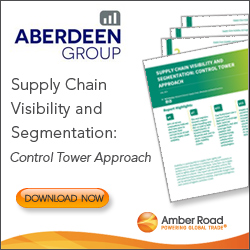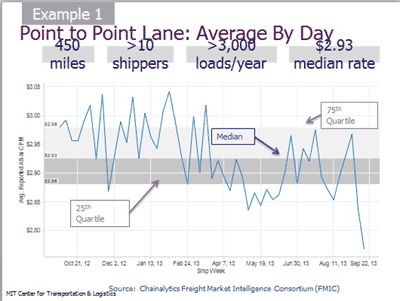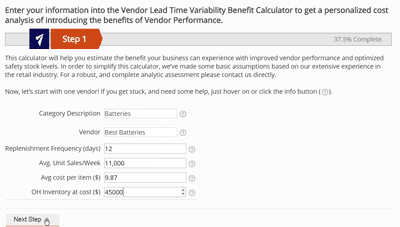 |
October 31, 2014 - Supply Chain Flagship Newsletter |
 |
| FEATURED SPONSOR: AMBER ROAD |
||
 |
||
Download this Complimentary Aberdeen Group Report to Learn how you can Improve End-to-End Efficiencies with a China Trade Management Solution |
||
 |
||
 |
|
|||||||||||||||||||||||||||||||||||||||||||||||||||||||||||||||||||||||||||||||||
Number 1: The Myth of the Market Rate: This one frankly surprised me a bit. Of course, there is great interest by shippers in identifying a "market rate" for a given lane, because naturally enough they want to know what they should be spending for that move. In great summary, Caplice says shippers are often largely wasting their time. My first question to Caplice was whether market rate means an average type rate or the best rate, and he said that can be a little fuzzy depending on the company. In general, however, while many would like to identify the best rate, most firms would be happy to just know the average. Many sign up to various benchmarking services out there to try to glean that intelligence, or do research work on their own. The first challenge, Caplice said, is that it is actually very hard to find enough data. Caplice and some others received full transportation details from 100 companies, and across all those shippers, amazingly, only 3% of lanes had data from more than two companies at the 5-digit zip code level. It was better at the 3-digit zip level - 25% had more than two shippers - but still the matches in general were too few to really draw strong conclusions. Confidentiality agreements with carriers serve as another barrier, Caplice says, but the real challenge is simply that "the market rate doesn't exist." To prove that point, he showed analysis from one lane for which there were about 10 shippers participating, with a total across them of some 3000 moves a year.
| Caplice showed it gets worse if you plot rates over this period by individual shipper. Some are consistent across the year in rate paid, some vary wildly up and down, some suddenly have their rate drop substantially (a new bid event?), etc. Truckload transportation is simply not a pure commodity as is often thought, he added, with every shipper having different needs and requirements, while the market backdrop is also changing a lot through the year. The bottom line: don't spend too much time, energy or money trying to identify a market rate for a lane when that just doesn't really exist. Benchmarks may provide some intelligence at times, but really should serve as just as one input into a complex equation as to what any given shipper should be paying. Number 2: The Myth of Combinatorial Auctions: This was a hard one for Caplice - he had actually done his doctoral dissertation on the opportunities from this approach, and touted the potential through much of the first decade of this century. What does this involve? The theory is that if carriers can bid simultaneously on a bundle of lanes, they can offer a lower total cost because of the resulting network and asset efficiencies a given bundle would generate for them. The problem, Caplice said, is that while the benefits are there in theory, in practice the concept falls apart, for a variety of reasons. First, few carriers actually submit such combination lane bids - less than 25% of carriers in fact to those shippers using this combo approach. Even those carriers which do submit combo bids usually do so for just a few lanes, or even just one combo. Second, 50% or so of the combo bids involve a simple out and back - to a destination and then back to origin. That is much more basic and simpler bundle than the combo method envisioned. While there were a few bids that involve multiple moves in a sort of tour that would end back at the origin and other more exotic moves, these were in fact very rare. Then there is the practicality of even these simple roundtrip moves. The carrier and shipper are betting that these out and backs will be there on a timely enough basis to make it work sometime in the future on a consistent basis. Anyone want to wager on that one? Now try making that work in even more complex combos. Not going to happen. On top of all that, these combos are rarely even less costly than just bidding out individual lanes. Almost unbelievably, in the data set Caplice used, the combo bid was only less expensive that the individual lane bids from the same carrier 16% of the time. We can thus infer that carriers presenting combo bids rarely win them. Logically enough then, in the rare cases when a carrier does win a combo bid, shippers rarely tender a set of loads in a way that matches that combination. To be clear, there is value in doing carrier bid optimization using fancy tools at the lane level, but extending that to combo bids, as should now be clear. is unlikely to deliver any real value. I will note as an aside that all this is also what is behind the great challenge shippers have in doing collaborative shipping with others, another concept that makes great sense in theory but is devilishly hard to get to work in practice. What a great question, which is at the heart of risk management, isn't it? Yet, how many companies really analyze and quantify it along this dimension? So, as an easy example, you could build a large dedicated or private fleet that insulates you from most capacity type issues that at various times plague others using all common carriers, but likely at higher total cost. MIT is working on models that will provide guidelines for shippers relative to managing this tradeoff - not sure when we will see it, but it looks like very interesting and valuable work. What is your reaction to Caplice's three myths? Agree or disagree? Let us know your thoughts at the Feedback button (email) or section (web form) below.
|
|||||||||||||||||||||||||||||||||||||||||||||||||||||||||||||||||||||||||||||||||
|
||||||||||||||||||||||||||||||||||||||||||||||||||||||||||||||||||||||||||||||||||
|
||||||||||||||||||||||||||||||||||||||||||||||||||||||||||||||||||||||||||||||||||
|
|
|
YOUR FEEDBACK
Catching up with some feedback from a few weeks ago on our First Thought column on "Consumer Goods Companies are from Mars, Retailers are from Venus."
Received a few good emails, including our Feedback of the Week from Andre Martin of JDA Software. You will find them all below.
Feedback on Best Cartoons Column:
I agree with everything you listed but what has been missing until now are two things. 1. The retail supply chain is interdependent whether we like to admit it or not and Jay Forrester from MIT proved it all the way back in 1958 when, working with a bunch of PhD students, he modeled a complete retail supply chain on a Univac computer. The results: a 10% increase in sales at the store level in January cascaded down to the supply chain and amplified to a 40% increase on the factory six months later. This demonstrated the retail supply chain was naturally linked regardless of what we think and regardless if we collaborate or not. Changes in consumer demand at store level will impact the entire retail supply chain and there is nothing we can do about it. Retailers and manufacturers have but two choices to deal with this:
2. Retailers and manufacturers then need to spend a certain amount of time understanding and educating themselves on what are the root causes of changes up and down the retail supply chain. This is not rocket science and can be quickly understood if only people take the time to do this. Then they need a way to create a model of how they wish to do business together. The model should consider the following:
Let me end with this statement: There is no guessing anymore in how to best manage a retail supply chain and flow product from the factory to the store shelf. What is now needed from retail and manufacturing executives is a genuine desire to take some time to learn how this has become a science today. It has taken a long time to get to this point but we have arrived. The enabling technologies are finally available but what is now needed is the will to do it. The financial benefits to retailers and manufacturers are absolutely huge and it is now in their hands to make it happen. Those who do it first will definitely create a competitive advantage for themselves. Andre Martin JDA Software
|
||
30 years ago I worked for a major computer manufacturer. I had started in the stockroom and progressed to a planner position for nuts, bolts, screws, cardboard and skids. This position lead to a more senior planning position where a team would go out to the field each quarter to do a sales force sensing. We had four regional sales units and this process was repeated in each unit.
|
||
I think you have really hit the nail on the head with this one. The fundamental problem is that retailers and manufacturers see the problems and opportunities differently. And that is a very large chasm to overcome. Add to that since the retailer is the customer, and that means in the end they are going to call the shots. Retailers have certainly gotten a lot better in supply chain, and that has made a difference, but even saying that they do not think about it the way a manufacturer does. Great insight - thank you. Adrian Gibson |
SUPPLY CHAIN TRIVIA ANSWER
Q: Dr. John Gattorna of Australia is generally credited with coining what term with regard to logistics outsourcing?
A: "4Pl," meant to characterize an outsourcer hired to manage other outsourcers, an approach common in the automotive sector, for example.
| © SupplyChainDigest™ 2003-2014. All Rights Reserved. SupplyChainDigest PO Box 714 Springboro, Ohio 45066 |
POWERED BY: XDIMENSION
|








